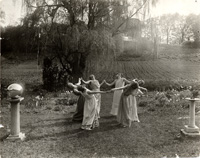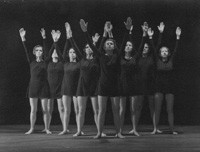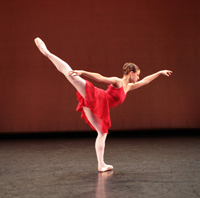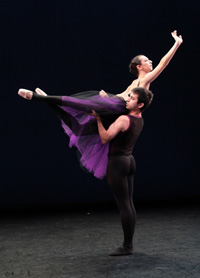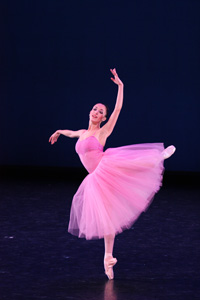The History of Dance at Vassar College
by Steve Rooks, Professor of Dance, with the assistance of Max Hershenow '10 and Stephen Xue '11
January 2011
Department Website
Dance at Vassar College had its very beginnings in the women's health education movement of the late 19th century. When Vassar first opened its doors in 1865, physical education and exercise were considered vital for the well-being of its students. Requiring students to take three to four periods per week of exercise, in addition to an hour of outdoor exercise, the college and its Board of Trustees were firm believers in the positive effects of physical movement, riding the wave of enthusiasm for physical education programs promoted by Catharine Beecher and Dio Lewis. Exercise, especially in the form of calisthenics, was regarded as "essential to success in study";. This dedication to physical health also translated to dance. Even when the morality of public dancing was debated, founder of the college, Matthew Vassar, championed it as "a healthful and graceful exercise."; Students were soon able to substitute a square dancing class for the required gymnastic drill. 1898, however, marked a turning point in the college's dance history—Vassar offered its first aesthetic dancing class, repositioning dance from a means of exercise to an independent art form.
Throughout the 20th century, dance at Vassar evolved significantly, incorporating a plurality of forms in its course offerings. These styles ranged from classic, aesthetic, folk, to clog, tap, and modern. Still, regardless of the progress during this time, dance at Vassar struggled to stand on its own. Operating as part of the Physical Education Department, the dance department had limited resources and facilities; in the late 70s, the dance department worked with an annual budget of $500. Drama was also involved with dance during this period, offering a dance concentration as part of its major. In 1979/1980 a proposal to separate the Dance and Physical Education departments was rejected due to the college's philosophical stance against the "proliferation of small departments."
As the country was enamored by the experimental post-modern dance that was emerging in the dance community, Vassar College looked back at the classics. Tremendous interest in ballet eventually led to a petition of 1184 signatures requesting that the college offer ballet courses. In 1978, ballet was offered for the first time by Jeanne Periolat Czula who came to the college from the world of professional dance. Determined to develop a strong program for Vassar, Czula has been a powerful and steady force behind making dance the serious and widely admired part of the college curriculum it is today. Although her proposal for an independent dance department was not accepted in 1979, the groundwork was laid for a self-managed department. In 1980 Vassar Repertory Dance Theatre (VRDT) was created after Ray Cook, a trained dance notator who was determined to introduce modern repertory to modern dance students, joined the dance faculty. Two years later the dance faculty managed to acquire Kenyon Hall's South wing as an exclusive space for dance. With VRDT having its own rehearsal space and giving annual concerts at the Powerhouse Theatre as well as the Poughkeepsie High School, the presence of dance at Vassar gradually became more salient. In 1982, VRDT had its first performance at the landmark 19th century Bardavon Theater in downtown Poughkeepsie and has since performed there for all of its annual galas.
In the spring of 2005, when the Physical Education department was in the midst of redefining itself, Czula proposed a separation of departments once more: twenty-six years after her initial proposal. This time it was approved. In 2006, with the support of Frances Fergusson, Vassar's ninth president, Kenyon was remodeled and Vassar's Dance Department moved into its new home, the newly renovated Kenyon Hall, replete with the 236-seat Frances Daly Fergusson Theater. The site of the new dance theater is the former Kenyon swimming pool whose handsome 1933 light fixtures have been reused within the new facility.
Today, the Department of Dance offers a non-major, elective course of study at Vassar. Courses for academic credit are offered in modern dance technique from beginner through advanced, classical ballet technique from beginner through intermediate IV, and jazz at the beginner through intermediate II level. In addition, Rooks, who was a principle in the Martha Graham Company and is currently chair of the department, teaches intermediate Graham technique and repertory. The Vassar Repertory Dance Theatre, now under the direction of John Meehan, formerly Director of the Hong Kong Ballet, remains a vibrant part of Vassar's dance program and performs throughout the school year. In the fall, VRDT presents First Showings and Final Showings, works in progress performances, in which the company can showcase student choreography in addition to the repertory.
In the spring semester, VRDT performs in ModFest, a Vassar arts festival, and its annual Bardavon Gala. Parents' Weekend performances are presented towards the end of the school year. The Department of Dance also runs a Master Class program, which annually invites experts in a particular area of dance to Vassar in order to broaden dancers' experience in technique, choreography and improvisation. Some of Vassar's Guest Artists have been: Irina Kopokova, Suzanne Farrell, Gelsey Kirkland, Arthur Mitchell, Anna Kisselgoff, Pilobolus with Adam Battlestein, Bill T. Jones, Donal McKayle, and more recently, Merrill Ashley, Take Ueyama, Tom Gold, Peter Pucci, and Sean McCurran. Vassar's Department of Dance is supportive of various dance groups on campus, sharing facilities with groups such as FlyPeople and Hype.
Sources
- Vassar College Encyclopedia (online), The Administrative History of Vassar College, Vassar College Special Collections, department files

